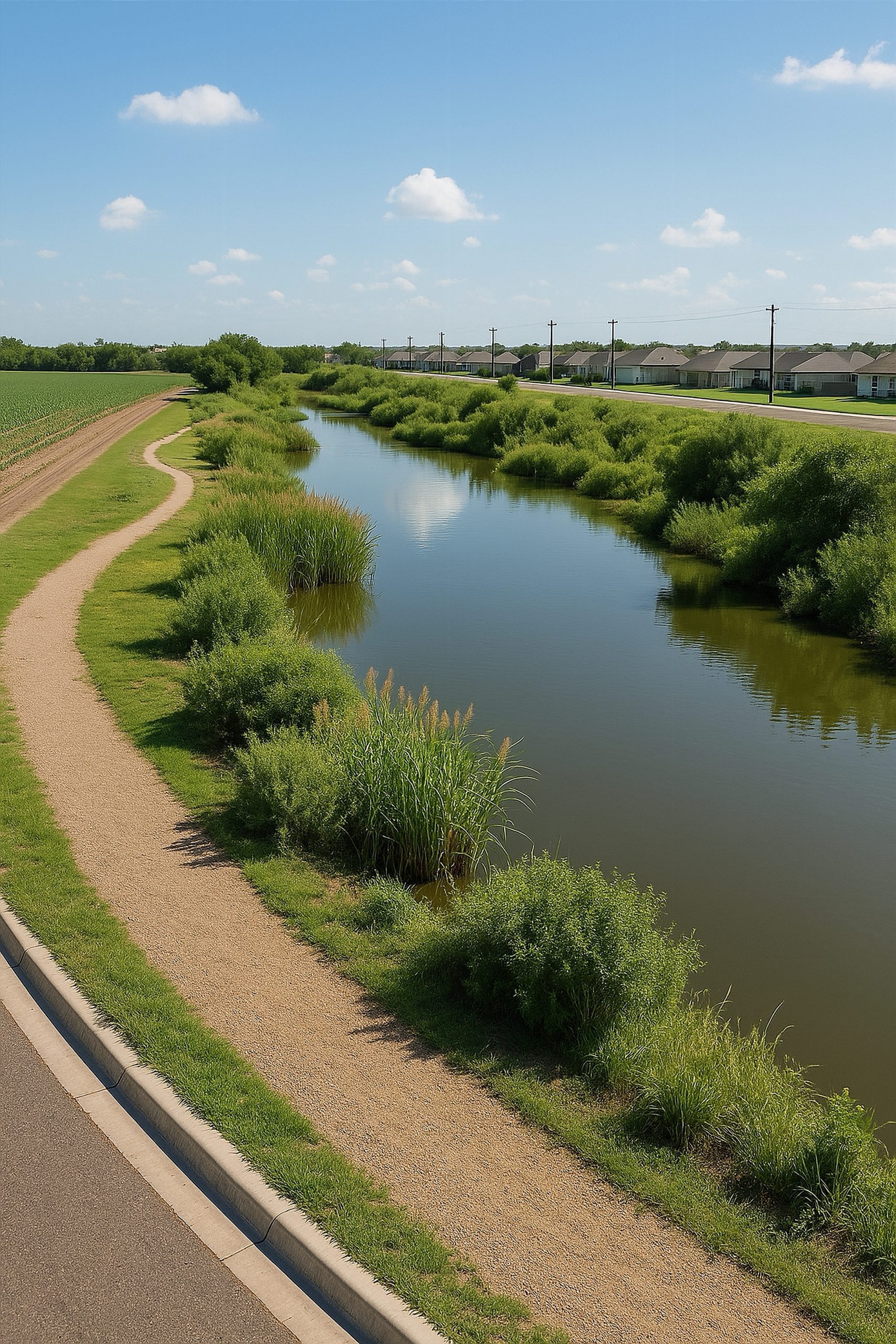- Agricultural runoff and urbanization have impaired the Arroyo Colorado River.
- Vegetated swales and wet ponds are cost-effective solutions under current conditions.
- Future scenarios show bioretention cells and porous pavements can reduce costs and land use.
- SWAT and SUSTAIN models were used to simulate runoff and pollution under changing land use.
- Combining farm-level BMPs with urban green infrastructure further cuts costs and nutrients.
Friday, May 23, 2025 — Agricultural fertilizers, urban sprawl, and sewer overflows have left the Arroyo Colorado River in South Texas struggling to support aquatic life. Now, new research offers a cost-effective path forward using green infrastructure to help meet water quality goals set by state and federal agencies.
A recent study published in Water by Pamela Mugisha and Dr. Tushar Sinha of Texas A&M University–Kingsville applied two advanced hydrologic models, the Soil and Water Assessment Tool (SWAT) and the System for Urban Stormwater Treatment and Analysis Integration (SUSTAIN), to evaluate pollution and runoff in the Arroyo Colorado Watershed. The researchers focused on nitrogen and phosphorus, nutrients that fuel algal blooms and deplete oxygen in the water.
by Pamela Mugisha and Dr. Tushar Sinha of Texas A&M University–Kingsville applied two advanced hydrologic models, the Soil and Water Assessment Tool (SWAT) and the System for Urban Stormwater Treatment and Analysis Integration (SUSTAIN), to evaluate pollution and runoff in the Arroyo Colorado Watershed. The researchers focused on nitrogen and phosphorus, nutrients that fuel algal blooms and deplete oxygen in the water.
Urbanization and Agriculture Drive Pollution.
The Arroyo Colorado River Basin spans more than 700 square miles in the Rio Grande Valley. Rapid urbanization and intense agricultural activity have transformed permeable lands into hard surfaces, increasing stormwater runoff and washing fertilizers, pesticides, and other pollutants into the river.
The U.S. Environmental Protection Agency has designated the Arroyo Colorado as an impaired water body. Under Section 303(d) of the Clean Water Act, Texas must develop and implement Total Maximum Daily Loads (TMDLs) to restore water quality. According to the Arroyo Colorado Watershed Protection Plan, that means an 18% reduction in phosphorus and a 21% reduction in nitrogen concentrations.
Modeling Shows What Works Best.
To explore options, researchers modeled runoff and nutrient loads under both current land use (2018) and projected 2050 scenarios using two different development forecasts (A1B and B1). The team then tested four types of green infrastructure: vegetated swales, wet ponds, porous pavements, and bioretention cells.
Under current land use, vegetated swales and wet ponds were the most cost-effective strategies, each achieving TMDL targets for around $1.5 million when paired with other low-cost farm and urban practices like residue management and street sweeping. Wet ponds covered more land but performed similarly to vegetated swales in reducing runoff and pollutants.
For future scenarios, vegetated swales remained cost-effective in the A1B scenario, while porous pavements were the most economical option under the B1 scenario. Notably, bioretention cells occupied the least land area and offered strong nutrient removal for about $2 million, making them attractive in urban settings with limited space.
A Mixed Strategy Offers Long-Term Savings.
The study found that combining agricultural and urban best management practices further reduced both costs and the number of required infrastructure units. For instance, nutrient management and terracing on farms helped offset pollution at the source, minimizing the need for extensive infrastructure downstream.
“Such stormwater management actions are relatively cheaper and provide significant cost savings in the long run for local governments and cities,” the authors noted .
.
They also warned that infrastructure design must consider future changes in land use and climate. The models assumed conservative construction costs and did not include long-term maintenance or conveyance system upgrades.
A Model for Other Watersheds.
The results provide a valuable roadmap for planners and policymakers seeking to restore impaired rivers in semi-arid regions. By blending urban green infrastructure with smart agricultural practices, the Arroyo Colorado River could be restored in a cost-effective, sustainable manner.
“This research emphasizes the need for collaboration between stakeholders at the watershed and farm levels,” the authors wrote .
.
The findings offer a replicable framework for other regions confronting similar challenges from development and agriculture.
Citation:
Mugisha, P., & Sinha, T. (2025). Effects of Green Infrastructure Practices on Runoff and Water Quality in the Arroyo Colorado Watershed, Texas. Water, 17(11), 1565. https://doi.org/10.3390/w17111565

